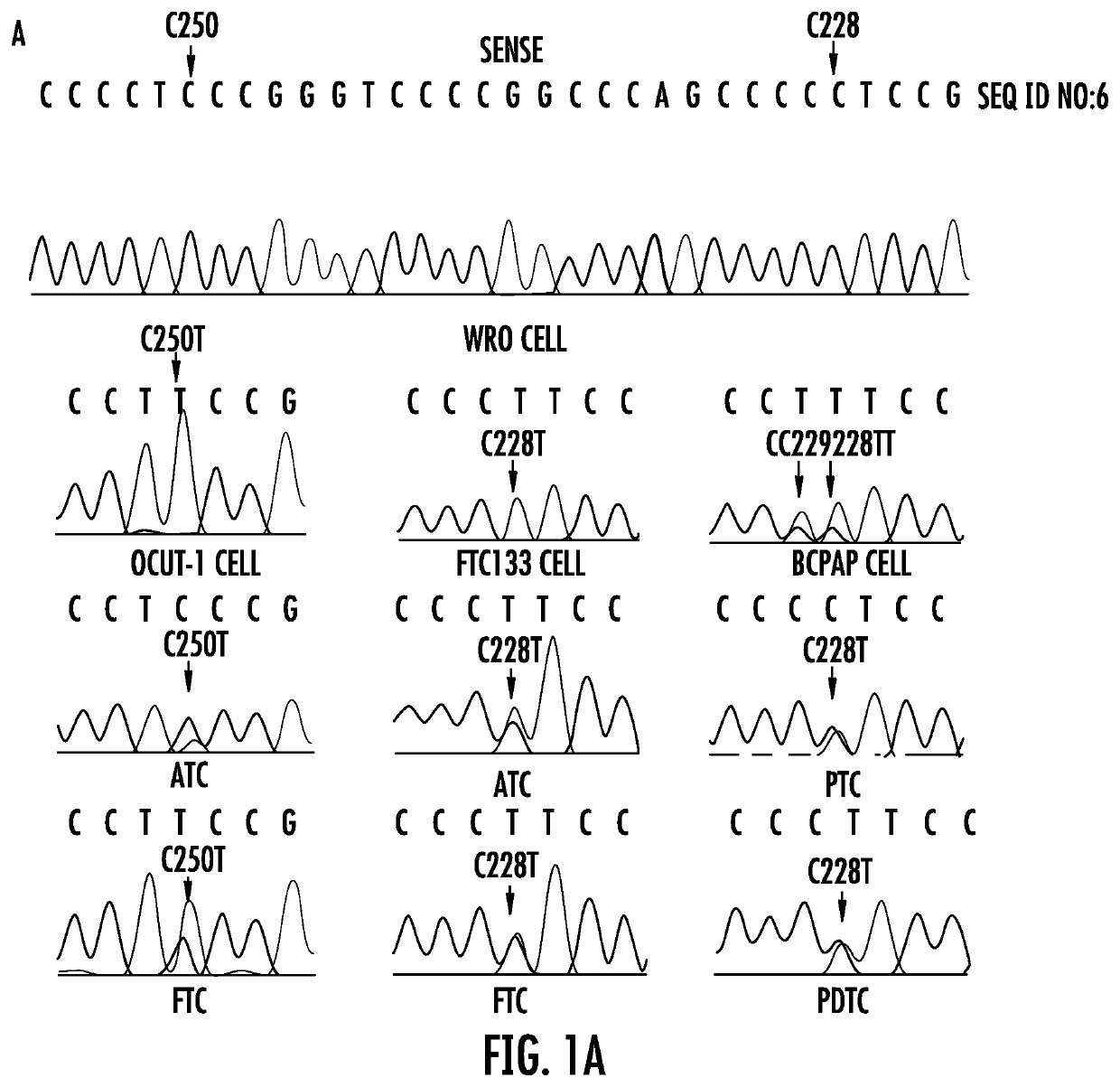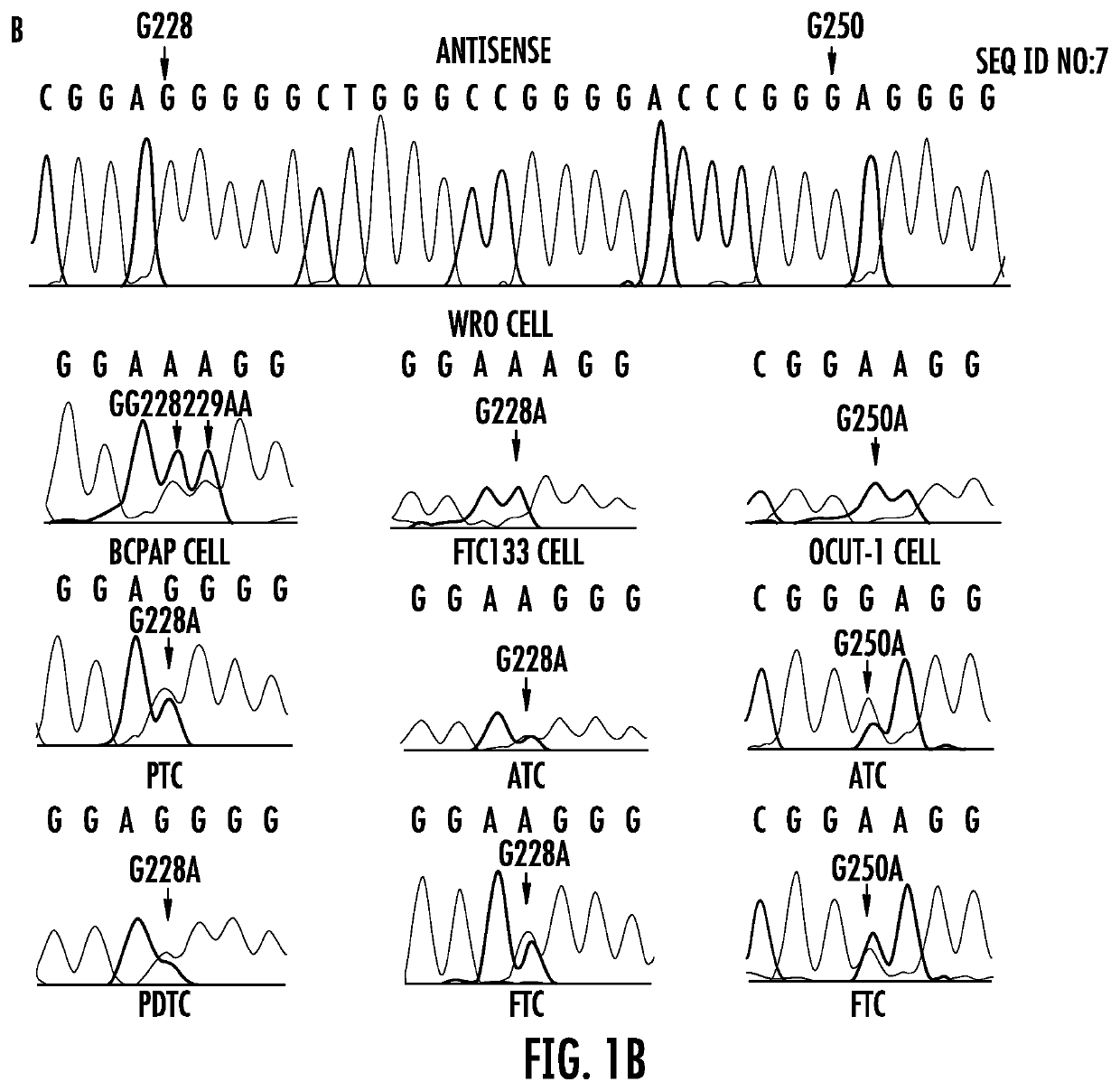TERT promoter mutations in cancer
a promoter mutation and cancer technology, applied in the field of cancer, can solve the problems of no effective treatment and a 10-year survival rate of less than 15% of patients
- Summary
- Abstract
- Description
- Claims
- Application Information
AI Technical Summary
Benefits of technology
Problems solved by technology
Method used
Image
Examples
example 1
Prevalence of TERT Promoter Mutations in Thyroid Cancer Cell Lines and Thyroid Tumors
[0099]In FIG. 1, representative electropherograms of the two TERT promoter mutations in thyroid cancer cell lines and various primary thyroid cancer tumor samples detected by both sense (FIG. 1A) and antisense (FIG. 1B) primers are shown. In Table 1, the TERT promoter mutation status of the 12 individual thyroid cancer cell lines tested is summarized. Except for the WRO cell line that harbored the wild-type TERT promoter, all the remaining 11 thyroid cancer cell lines examined harbored TERT promoter mutations. PTC and FTC cell lines only harbored the C228T mutation, while the ATC cell line harbored both the C228T and C250T mutations. Table 2 summarizes TERT promoter mutations found in all the thyroid cancer cell lines and primary thyroid tumors. The two mutations were collectively found in 11 of the 12 (91.7%) thyroid cancer cell lines. The C228T mutation was found in 0 of 85 (0.0%) benign thyroid t...
example 2
Association of TERT Promoter Mutations with Aggressive Types of Thyroid Cancers
[0101]CPTC, FVPTC, and TCPTC account for the vast majority of PTC variants. TCPTC is classically known to be more aggressive than CPTC and FVPTC. As shown in Table 3, TERT promoter mutations were significantly more prevalent in the TCPTC samples than in the CPTC and FVPTC samples, 30.8% (4 / 13) in the former vs. 10.3% (25 / 243) in the latter two (P=0.046, per two-tailed Fisher's exact test). TERT promoter mutations were highly significantly more prevalent in the ATC samples than in the DTC samples, 46.3% (25 / 54) in the former vs. 12.2% (41 / 336) in the latter (P=3×10−8). There was a trend towards a higher prevalence of TERT promoter mutations in the PDTC samples than in the DTC samples, 37.5% (⅜) in the former vs. 12.2% (41 / 336) in the latter (P=0.069). Statistical significance was not reached, probably due to the relatively small number of PDTC samples.
[0102]
TABLE 3Association of TERT promoter mutations wit...
example 3
Association of TERT Promoter Mutation C228T with BRAF V600E Mutation in PTC
[0103]BRAF V600E mutation, which activates the MAPK pathway, is the most common mutation in thyroid cancers, particularly in PTC (Xing 2005a). We, therefore, analyzed the relationship between this mutation and TERT promoter mutation C228T in PTC. As shown in Table 4, TERT promoter mutation C228T more commonly occurred in the PTC samples harboring the BRAF V600E mutation than in the PTC samples harboring the wild-type BRAF gene, with a prevalence of 18.3% (19 / 104) in the former vs. 7.2% (11 / 153) in the latter (P=0.0094, per two-tailed Fisher's exact test). Conversely, BRAF mutation more commonly occurred in the PTC samples harboring the TERT promoter mutation than in the PTC samples harboring the wild-type TERT, 63.3% (19 / 30) in the former vs. 37.4% (85 / 227) in the latter (P=0.0094). Thus, the majority of the TERT promoter mutation-positive PTC samples harbored the BRAF V600E mutation. Several cases of ATC had...
PUM
| Property | Measurement | Unit |
|---|---|---|
| temperature | aaaaa | aaaaa |
| pH | aaaaa | aaaaa |
| pH | aaaaa | aaaaa |
Abstract
Description
Claims
Application Information
 Login to View More
Login to View More - R&D
- Intellectual Property
- Life Sciences
- Materials
- Tech Scout
- Unparalleled Data Quality
- Higher Quality Content
- 60% Fewer Hallucinations
Browse by: Latest US Patents, China's latest patents, Technical Efficacy Thesaurus, Application Domain, Technology Topic, Popular Technical Reports.
© 2025 PatSnap. All rights reserved.Legal|Privacy policy|Modern Slavery Act Transparency Statement|Sitemap|About US| Contact US: help@patsnap.com



